An Investigation into the Techniques used by Artists to Create Representational Portrayals of the Human Figure
Introduction
The human figure is an interesting prospect to any artist, as there is a large scope for interpretation within any piece of figurative work. An artist’s interpretation of how a person looks can differ greatly; some artists are likely to emphasise the negative aspects of a person’s genetic makeup, whilst conversely others will prevent the exact emulation of somebody by altering, or to a more dramatic extent, not including characteristics or flaws of a persons figure.
Realistically painted portraits were most common in the 17th Century onwards, when portraiture was used to capture the likenesses of various royalty and the ruling classes throughout history. This century has seen a developing trend in the representation of figurative pieces, with the styles of some artists becoming looser and to some extent, abstract. However, this has not devalued the production of realistic portrayals, which are still widely recognised as being a major test of an artist’s strength. This is no doubt down to the extreme difficulty artists face capturing the exact likeness of their subject whilst also keeping a sense of emotion within the piece to prevent the final production from looking uninteresting and potentially dull. This, coupled with potential pitfalls such as a lack of three-dimensional quality in the artist’s work, and a need for well-balanced lighting and colourin the model’s face and figure, make figurative painting arguably the most challenging form of art.
The figure and the portrait have been painted for centuries and the style contains some of the greatest works ever produced in the art world. From the classical paintings of the Renaissance period, pieces of timeless beauty such as Botticelli’s ‘Venus de Milo’; more abstract works such as the ‘Weeping Women’ by Picasso, through to the extreme photo realism techniques used by artists such as Chuck Close. The different styles of these artists show the diversity, both in technique and appearance, achievable when creating figurative artwork. Capturing the figure and face, however basic it may be is one of the most commonly produced forms of art because of its prevalent nature in society, everywhere you look there are people – models to copy and interpret in your own way. This investigation will reveal the differences in the way two artists, Lucien Freud, and Richard Phillips represent the figure, and how their techniques differ to achieve this.
Critical Analysis – Freud’s Queen Elizabeth II Portrait
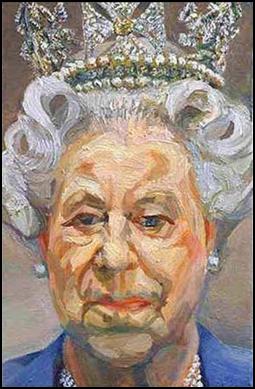 The first panting I have chosen to study is a portrait of Queen Elizabeth II, produced in the medium of oil. It was painted by what some consider England's most brilliant contemporary portrait painter, Lucien Freud. A royal representative with regard to painting a portrait of the queen approached Freud to produce this non-commissioned piece back in 2001.
The first panting I have chosen to study is a portrait of Queen Elizabeth II, produced in the medium of oil. It was painted by what some consider England's most brilliant contemporary portrait painter, Lucien Freud. A royal representative with regard to painting a portrait of the queen approached Freud to produce this non-commissioned piece back in 2001.
Freud painted the Queen's portrait for free, thus eliminating the money power aspect of the sitter-artist dynamic. Some say he painted the ageing Queen as ruthlessly as he had painted his ageing self. There may be something to be said for an artist and a Queen both coming to terms with death and no longer concerned with the image of youth and power. Although the piece was not created to express the personal feelings of the artist, you could argue that the style in which the painting has been produced conveys the Queen in an unconventional manner.
This figurative piece is painted in Freud’s acclaimed style, with earthy colours, thick brushstrokes and a high use of light and shadow within the face. Visually, the piece is subtle rather than being instantly striking. Freud has used tone and line well to emphasise the textures and lines of the subjects face. The colours within the piece are a mixture of dark greyish tones, the more vibrant but yet still subtle blues of the blazer and the peachy colours of the Queen’s face. Even in areas where there is grey colour such as the hair or the crown, Freud has still cleverly incorporated a wide palette of colours ranging from purple, to green, to yellow.
The composition is quite unorthodox when compared to traditional portraits, as the subjects face is close up, with the symbolisation of power given by the crown at the top of the piece. There is also an artificial light source, shined on the subject’s face but it is just there to emphasise the different areas of the face, rather than dramatically changing the paintings overall look.
A Reverential appearance coupled with symbols of power and deference emphasises the class gap between the royal family and the countries population, and is also the traditional style in which a royal painting is produced. However, Freud’s portrait portrays the Queen in a different manner. The portraits composition has focused on the top front part of the Queen's neck, face and bottom to middle part of her crown. There are no symbols, albeit the crown, to indicate her true social position. Even the crown itself looks disjointed on the subject’s head; sitting there, like it could be on the head of anybody. The fact that it is slightly cut off at the top could also suggest that Freud wanted to concentrate on the Queen’s ageing face rather than her main symbol of power.
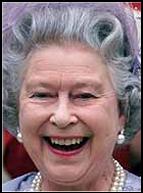 The basis of the controversy, which surrounded the piece at the time, is based upon the way in which Freud portrayed the appearance of the Queen. In the piece, the Queen’s face looks glum, the lack of a smile gives the impression that she is miserable, and her face expresses several emotions such as boredom, and tiredness. Compare it to a photographic image of the Queen in person (left) and there is a striking difference. Freud has been quite cruel in the shape of the Queen’s face, which looks quite manly. The artist does not provide her face with a smooth sensual paint finish of her past beauty, instead opting to emphasise the wrinkles of her face.
The basis of the controversy, which surrounded the piece at the time, is based upon the way in which Freud portrayed the appearance of the Queen. In the piece, the Queen’s face looks glum, the lack of a smile gives the impression that she is miserable, and her face expresses several emotions such as boredom, and tiredness. Compare it to a photographic image of the Queen in person (left) and there is a striking difference. Freud has been quite cruel in the shape of the Queen’s face, which looks quite manly. The artist does not provide her face with a smooth sensual paint finish of her past beauty, instead opting to emphasise the wrinkles of her face.
Personally, I think the piece, although painted in a harsh style is a natural representation of the Queen’s aged face. I also think that Freud was brave to paint this controversial piece, especially considering she is arguably one of the most respected and important figures in the world. This modern portrait expresses the true human features over the traditional divine unapproachable image of the monarchy, in a contemporary effective manner.
As a continuation of my investigation, I decided to produce a portrait of the Queen, in the same composition as Freud’s portrait. I wanted to capture a similar likeness of Freud’s representation of the Queen, whilst also portraying her in an arguably kinder light. I achieved this, using the medium of oil, but not focusing as much as Freud on the wrinkled areas of the Queen’s eyes and mouth. I am pleased with the outcome of the piece, as I feel it is a truer representation of the Queen’s general appearance. I used warmer skin colours, and changed her expression slightly, to make the Queen seem in a more content mood. This I feel is a fairer and admirable representation of one of the most respected Monarch’s of all time.
Critical Analysis - Freud’s Kate Moss Portrait
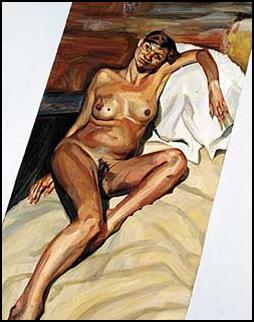 The second piece, also by Freud, is an oil painting of the famous British model Kate Moss. It was produced in Freud’s personal studio in London. Freud's decision to paint the supermodel was indirectly prompted by Kate Moss herself. In an article reproduced in the style magazine ‘Dazed and Confused’ the model revealed that one of her remaining unfulfilled ambitions was to pose for Freud. Months later, Moss’ ambition was fulfilled.
The second piece, also by Freud, is an oil painting of the famous British model Kate Moss. It was produced in Freud’s personal studio in London. Freud's decision to paint the supermodel was indirectly prompted by Kate Moss herself. In an article reproduced in the style magazine ‘Dazed and Confused’ the model revealed that one of her remaining unfulfilled ambitions was to pose for Freud. Months later, Moss’ ambition was fulfilled.
The painting wasn’t commissioned but the intention was for the piece to be sold at auction. When the painting was sold to an anonymous bidder in February 2002, it sold for the high price of £3.9 million. As in the case of Freud’s portrait of Elizabeth II, it came as quite a shock in the art world that Freud would also be painting Moss. This is because most of his models are people who are known to him, and who play some part in his everyday life. He chooses his subjects, he says, "on impulse", but in this case, the sitter herself prompted Freud’s impulse.
From Freud's point of view, Moss was an unexpected choice of subject, because he has often said that the last thing he wants to paint is a professional model. He wants to paint a real person, not a practised holder of poses, and there can scarcely be a more practised and professional model in the world than Kate Moss. Although Freud is renowned as a slow working artist compared to some of his peers, the painting was completed in a reasonably short period of time by Freud's standards, because of the natural deadline the model’s pregnancy produced. You could easily argue that the piece was created not only because of Moss’ request, but also because Freud wanted to paint a defining piece of art history that reflected and conveyed a strong image of counter-stereotypical beauty in the public domain.
Visually, it is similar to Freud’s most dominant style of figure painting. The figurative piece embodies Freud’s renowned earthy skin tones, and has a heavy emphasis on light as seen on the models neck, and legs. Like the majority of Freud’s figurative work, including self portraits of himself, he does not eroticise or flatter his subjects, he paints them expressionless, allowing the viewer to experience a strong sense of the subject’s presence as a human being, as flesh and bone, rather than a portrayal of their current mood. Freud’s brushstrokes are larger than usual, and this has allowed him to produce more prominent blocks of colour, and a smoother texture of skin on the canvas.
The painting shows a pregnant Kate Moss lying in a relaxed posture over a bed. With rounded belly and a discreet little fold of skin beneath her right breast, Moss’ appearance is perhaps a true representation of the female figure. This is a more ‘womanly’, voluptuous, flesh-and-blood Moss, a figure that contrasts dramatically against the wispy, ethereal creature she often appears as in photographs. The artificial light source, shining most dominantly on her shins at the foot of the page, was perhaps purposely set up by Freud as this part of her anatomy is seldom shown in Moss’ fashion shots. Her face recedes into the background and her calves are prominently displayed; this is Moss as few have ever seen her. Freud’s painting certainly portrays an unfamiliar image of the supermodel.
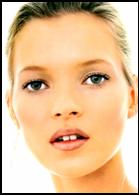 Moss’ slouched posture gives the impression she is not the elegant being she always appears to be. The roll of skin under her breast also emphasises the increased weight the pregnancy has brought and also symbolises an aspect of the body that a model will always strive to banish. Compared to the photo of Moss (left), the painting contains duller looking skin colours, a far cry from the peach coloured perfection of Moss’ photographed face and body. Freud has arguably painted Moss’ head a fraction too small in comparison to the rest of her body, and the fact that the models face looks so dissimilar to how it is normally portrayed is perhaps a negative aspect of the piece.
Moss’ slouched posture gives the impression she is not the elegant being she always appears to be. The roll of skin under her breast also emphasises the increased weight the pregnancy has brought and also symbolises an aspect of the body that a model will always strive to banish. Compared to the photo of Moss (left), the painting contains duller looking skin colours, a far cry from the peach coloured perfection of Moss’ photographed face and body. Freud has arguably painted Moss’ head a fraction too small in comparison to the rest of her body, and the fact that the models face looks so dissimilar to how it is normally portrayed is perhaps a negative aspect of the piece.
Many who view the painting will associate with the way the flesh is so awkwardly hanging from the bones. Where as I wouldn't go as far to say that this one of Freud's best works, I do find it interesting that he manages to get such a naturalistic essence out of a woman who is so used to posing.
The idea behind the piece seemed tantalising on paper, and yet Freud has also been able to produce a piece that, although controversial, like the Queen’s portrait, has justified strength both in its form and composition, whilst also portraying Britain’s most famous supermodel with a new, perhaps unconventional essence of beauty. She is, as Freud often prefers with his subjects, completely naked. Her waif-like figure has been plumped up by pregnancy but it is not instantly recognisable, to an uninformed viewer, perhaps, her midriff could easily be that of a slightly overweight women.
It is all too easy to overlook the artist’s powerful depth within the painting of Moss’ inner beauty, when on first impressions the painting is not a striking resemblance of how Moss is usually portrayed in the media. In a similar fashion to Freud’s Elizabeth II painting, Freud has painted his subject somewhat harshly, and presented them with an emphasis on their natural imperfections.
Critical Analysis – Phillips’ Elena Andreas Portrait
After investigating the figurative works of Freud, I will now study the portraiture of a lesser well-known American born artist, Richard Phillips, and compare his techniques to that of Lucien Freud’s. Over his career, Phillips’ has developed a striking signature style that derives its tension from a selective use of provocative model poses, that he subjects to the technical, value-laden refinements of his academic painting experience.
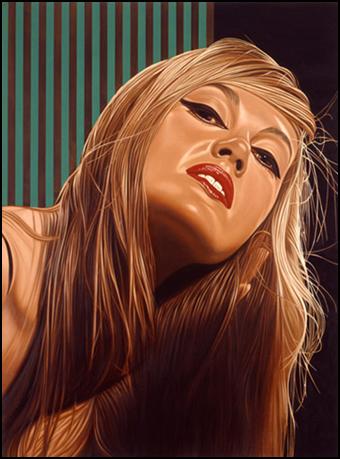 Unlike Freud, Phillips’ portraiture work is painted from original photographs which he mechanically grids up to paint an exact likeness from. Freud however, works with his subjects from direct observation, which makes capturing the likeness of Kate Moss and Queen Elizabeth, much harder. You could also argue that a large amount of work is already done before Phillips’ even starts painting because the photographer has already captured the composition and pose of the model previously. Consequently, Phillips’ work does not have the same sense of originality that Freud’s portraits encompass.
Unlike Freud, Phillips’ portraiture work is painted from original photographs which he mechanically grids up to paint an exact likeness from. Freud however, works with his subjects from direct observation, which makes capturing the likeness of Kate Moss and Queen Elizabeth, much harder. You could also argue that a large amount of work is already done before Phillips’ even starts painting because the photographer has already captured the composition and pose of the model previously. Consequently, Phillips’ work does not have the same sense of originality that Freud’s portraits encompass.
Phillips’ technique of applying brushstrokes is very different to that of Freud’s. He chooses to paint on linen, rather the traditional choice of canvas, as his work relies on the immaculate use of blending colours to produce work that not only looks realistic, but also contains a certain smooth, almost doll-like texture. In contrast, Freud has used thicker, more elaborately applied brushstrokes in his two portraits, as he is not trying to achieve the same level of realisation seen in Phillips’ work.
There is a deceiving lack of facial detail in Phillips’ Andreas portrait. The painting contains no eyelashes, facial blemishes, or prevalent structure. The strong contrast of the white light with the skin tones makes the model’s face look shiny in nature, and subsequently unnatural. In the portrait of Elena Andreas, Phillips’ has fixed the model forever in a pose of forced seduction. It gives a sinister slant to the subject’s appearance; you could argue that the model is stylised to within an inch of her life. In contrast to Freud’s portrait of model Kate Moss, the subject is in a much more natural and less imposing pose, far away from her accustomed world of make-up and studio lighting.
Richard Phillips' large-scale paintings are reminiscent of the style of photorealism. Although his style of portraiture is not as detailed as work by artists such as Close, Phillips’ work does expand on the historic role of photorealism. In earlier photorealist paintings, the subject matter was usually mundane and uninteresting - the true subject of the work being the way we unconsciously interpret photographs and paintings in order to create a mental image of the object represented. Conversely, Phillips' recreated portrait of the model takes an image that has been rendered neutral by the ubiquitous nature of its existence, whilst still managing to infuse the model with a sense of sublime presence.
The beautiful and banal models (pictured below) stare at the viewer in a bold manner, their faces rendered to perfection, complementing nicely with the striped backgrounds. These coloured stripes are a throwback to the pop art style that was most popular around the time the model’s photographs were taken. In the portrait of Andreas, the green coloured stripes are effectively used, as they neutralise the brightness of the model’s skin colour. For Freud’s portrait of the Queen, a dull grey background is used which matches the solemn mood of the piece; in Phillips’ Andreas portrait, the dark black brings the model’s face successfully to the foreground.
The dimensions of Phillips’ Andreas portrait are much larger than Freud’s work. The viewer is presented with a vast, near-photorealist image of a lascivious young woman. Compared to Freud’s work, the size of the portrait is larger so Phillips’ can incorporate a high amount of detail. The consequence of this large size is that the initial impact of the subject’s face is much greater in Phillips’ work.
In Phillips’ portrait of the model, there is heavy lighting that contrasts with the flat lighting seen on Freud’s portrait of the Queen. The makeup and hair colour of Phillips’ portrait emphasises the beauty and youth of the model, creating a stark comparison to the frail looking Queen, with her aged grey hair and wrinkled face. The bright colours used for the hair, and face tone of Phillips’ model portrait makes the piece seem vibrant and youthful. Conversely, Freud uses darker hues of colours in his work to infuse a sense of mood into his work.
Conclusion
Richard Phillips’ unique style has continued to attract acclaim and controversy over the past decade, because of the nature of the subject matter he has chosen to recreate via painting. Freud’s work has also been under scrutiny for his controversial representations of the Queen, and to a lesser extent, Kate Moss. Even under the mass controversy, both artists have successfully achieved their goals of portraying the human figure in very different ways. It has to be said, that the composition of Freud’s painting of Moss is very important. The painting would create little impact, if it were not for the model’s naked body being somewhat slothfully laid across the bed, as this is central to the overall feeling of the piece. Conversely, only seeing the head of the subject in Phillips’ work focuses the observer on the beauty of the model’s face.
Lucien Freud broke down a traditional barrier when painting royalty, by allowing the Queen to be represented in an initially shocking, unattractive manner. Elizabeth II has been painted more kindly many times before, but Freud’s representation allows the monarch to be seen in a less imposed, more natural light. Moss too, one of the archetypes of British beauty has been stripped of her commonly portrayed beauty. But it is not until you realise that, Moss is pregnant, comfortable in her own current form of body, and happily away from the strict regime of photograph shoots that you realise the true beauty of the piece. Freud’s somewhat harsh representation in his two portraits is the ultimate contrast of Phillips’ paintings of photo shoot beauty. Phillips’ has developed an interesting style of modern portraiture that is uncommon, yet very impacting and aesthetically pleasing to the eye. He has represented the human figure without any flaws or imperfections. Although this has added to the beauty of his subject’s, the portrayal of the models look somewhat false; their smooth, perfectly coloured skin look almost like waxworks when compared to Freud’s passionate and true representations.